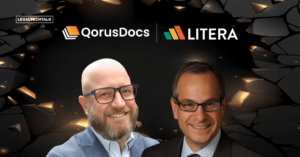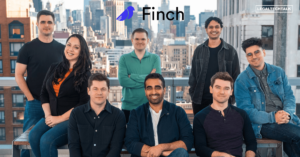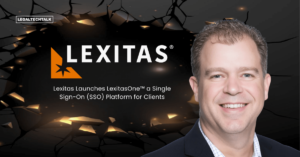In this exclusive interview, Bradley Collins sits down with Lillian Breidenbach, Co-founder and Managing Director at LegalOS, to dive into the world of Legal OS. Lillian shares the company’s unique journey and vision, where they’re leveraging cutting-edge technology to revolutionise legal processes in enterprises.
From reducing wait times to automating queries, Legal OS is on a mission to transform the legal industry. Lillian also discusses the critical aspects of security, adoption, and offers valuable advice for legal departments seeking innovation approval.
Bradley Collins: Hi Lili, a pleasure to catch up with you – to kick things off, I’d love to know a little about Legal OS, what’s the story?
Lillian Breidenbach: We’re not lawyers. We’re product people and designers, engineers and data scientists. But what drew us to law is our team loves big, untouched problems. For the last couple of years, we’ve wondered if it would be possible to reduce wait time on legal in enterprises down to zero. At the same time, how could we reduce repeat tickets landing on legal’s desk to zero? Obviously, it seemed impossible. This is why we fixated on it. Then ChatGPT arrived and we thought, huh, maybe we aren’t so crazy after all. By mid-January we had a prototype. By April, our first users.
Legal OS enables in-house teams to spin up bots based on their knowledge, then deploy these where their business teams (sales, marketing, etc.) are already working. So we see bots in Slack, MS Teams, or via our Chrome extension. And now, within just a few months of launch, we have customers automating thousands of queries each month.
But really, we see this as just the beginning. Our early customers – the likes of TravelPerk, Mural, DeepL, and DocPlanner – are so fast and creative in their adoption of the product, that we’re already driving more advanced use cases, support for more languages, and continual refinement of the bot’s performance. We want bots built on Legal OS to feel like a member of the legal team, they shouldn’t be intrusive nor one dimensional.
Legal On-Demand, that’s the vision.
Bradley Collins: You’re operating in perhaps the most risk-averse industry of them all – what are you doing to ensure absolute security for the companies you’re working with?
Lillian Breidenbach: Security and accuracy are our top priorities. Before we launched into the public, we spent countless hours on accuracy. We noticed many AI tools in other industries had fairly simple architectures. They’d throw a prompt at ChatGPT and say a prayer. This might work for a marketing use case, but in legal & compliance, accuracy is table stakes. In our approach, we orchestrate a dozen modules together, leveraging multiple LLMs. Each module has a simple task; this ensures we can control the output, it’s predictable and consistent. On top of this, we scan the output of every module using more traditional methods like ‘diffing’. And in case the bot doesn’t have an answer, it won’t answer! Our focus is on building secure, controllable, and auditable AI that gives legal teams peace of mind.
The work to ensure accuracy is painstaking, but it never stops. With security, there’s more of an established set of best practices for us to lean on. As a German company, we have a wealth of experience in complying with strict data protection laws, especially when working with law firms. Our system provides each customer with a dedicated, private instance that is completely isolated from others. We ensure separate servers, databases, and language services. This design ensures that each client’s data and operations remain confidential and protected at all times.
We’ve designed our AI system to be highly adaptable and safe. It’s structured to prevent common issues seen in similar systems like ChatGPT. We ensure the bots responses are based solely on user-provided information and legal teams have full control over the answers that are given. Finally, our ‘fine-tuning’ intervention allows one-shot corrections to answers into the system, so that if the system makes a mistake, it will not repeat it.
Bradley Collins: Interesting! The legal departments I’ve been speaking with seem to struggle with getting company-wide adoption of any new technology – how are you approaching this?
Lillian Breidenbach: The beauty of this kind of technology is that implementation and adoption is rapid. The product is plug and play and a first use case can be implemented and deployed in a matter of hours. Once employees witness real-time answers to questions that traditionally took days, they push for access and adoption becomes viral.
This momentum stems from three pillars central to our product:
Zero friction: Legal OS integrates seamlessly where work already occurs, available precisely when required. It avoids extra platforms, logins, or hurdles. For instance, sales teams access our bot in tools like Slack, MS Teams, or Salesforce, bypassing additional onboarding. They receive instant legal answers right where they operate.
No learning curve: Engaging our bot feels like collaborating with a new teammate. It’s intuitive, requiring no special training or orientation.
Targeted responses: Legal teams can fine-tune and configure the bots, ensuring responses match the desired wording, tone, brevity and format (e.g. email) for each specific business use case.
Bradley Collins: Finally – is there any advice you can offer legal departments that are struggling to get sign-off on innovation projects from your experience?
Lillian Breidenbach: Legal departments often lack a dedicated software budget, making approvals harder than for other teams.
For our customers, two strategies have proved effective:
Highlight business-wide ROI: It’s crucial to demonstrate how a tool can benefit not just the legal team, but the entire business. At Legal OS we see a completion rate of 99.7% for some use cases. Meaning only 0.3% of requests need to be escalated to a human which has a material impact on top-line growth (closing deals faster) and material impact on bottom-line efficiency (reducing CAC via fewer unnecessary communication touchpoints).
Start small: Start with targeting a distinct, measurable use case to quickly deliver value. The outcomes are used to create an internal case study, which then sets the stage for the roll out to other use cases and teams. Before allocating substantial resources, they can validate the tool’s value to the company.
Key Takeaways:
1. Prioritise accuracy and security: When adopting AI solutions, focus on accuracy and security as top priorities. Implement robust systems that ensure predictable and consistent results, especially in risk-averse industries like legal and compliance.
2. Ease of implementation is crucial: Choose technologies that offer rapid implementation with minimal friction. The plug-and-play approach, combined with intuitive user experiences, can drive viral adoption within your organisation.
3. Demonstrate business-wide ROI: When seeking approval for innovation projects, highlight how the technology benefits the entire business, not just the legal department. Showcase measurable outcomes and start with small, impactful use cases to build a case for broader adoption.








